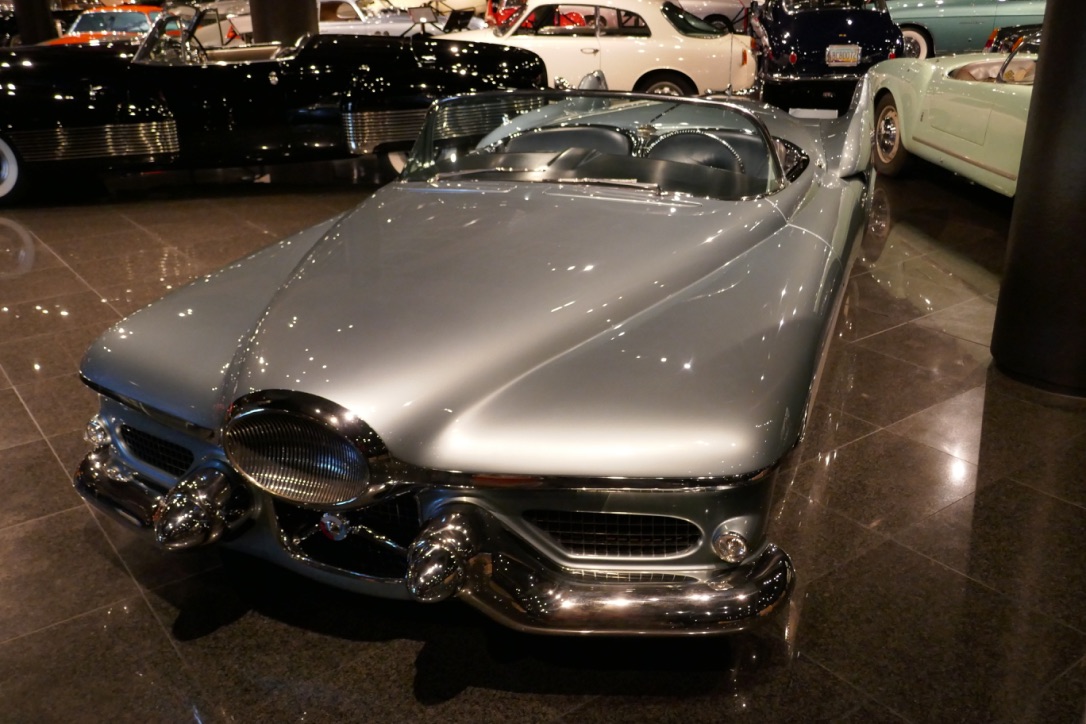

![{{{1}}} [CC BY-SA (https://creativecommons.org/licenses/by-sa/2.0)]](https://nextview.vc/wp-content/uploads/2020/01/1024px-1939_..._Harley_Earl_and__The_Y_Job_.jpg)
20/20/20 – Harley Earl: Design Icon, Seer of Our Autonomous Vehicle Future
Over the course of 2020, we are highlighting 20 innovators and entrepreneurs from the 20th century whose work continues to shape our everyday lives in the 21st century.
Unless you are a student of design or an aficionado of cars, you may not know the name Harley Earl. But one can make the argument that Earl was to the 20th century what Jony Ive has been here in the 21st century.
Ive, Steve Jobs, and Apple didn’t invent the mobile phone, but the iPhone (and smartphones generally) have revolutionized our world, and will undoubtedly go down as one of the more consequential innovations of the 21st century. Similarly Harley Earl shaped one of the most consequential innovations of the 20th century… the automobile. His design ideas and vision of the future, which go back nearly 100 years at this point, continue to echo in the world of transportation today including alternative propulsion and autonomous vehicles.
Harley Earl brought the concept of design to the automotive world, and in doing so played a meaningful role in making cars a mass market phenomenon, particularly in the post WWI era. But his start goes much further back than that. In 1927 General Motors created the “Art and Color Section” and made Earl its first director.
Prior to this, design was not a consideration of auto manufacturers, cost and technical engineering were the primary influences. Henry Ford, (innovator in his own right with the creation of mass production) famously dismissed any sensibilities about design saying customers could “have their Model T’s in any color they want, as long as it’s black.” GM’s Art and Color Section subsequently evolved into the Styling Division and Earl became one of the most influential executives at the company.
Now anytime a new car is developed, one of the key milestones is the public unveiling of a “concept” car. Today these are glitzy affairs like Elon Musk’s recent presentation of Tesla’s Cybertruck. Harley Earl is the one who actually invented the notion of a concept car; the world’s first concept car was his Buick Y-Job unveiled in 1938.
For comparison, when Earl created the Art and Color Section in 1927 contemporary cars looked like this:
At the time, most cars still had design cues from the era of horse carriages, running boards to step into the vehicle, separate headlights mounted to the front fenders (evolution of lanterns), manually operated windows, etc. Most of the features that became standard in the 1950s-60s were first seen on the Y-Job nearly two decades earlier.
Earl also established many of the tenets of auto design that persist today. He began techniques like freeform sketching of cars and clay modeling of prototypes, both of which are standard practice today, even with the advent of computer aided design techniques. Having both an art background and engineering training (Earl attended Stanford in his early years), Earl and his team came up with a huge number of the features we now think of as commonplace on cars: electric windows, heated seats, keyless entry, onboard computers, power convertible tops, etc.

1951 GM Le Sabre concept (foreground) & 1938 Buick Y-Job (background left) [Photo: Lee Hower]
Henry Ford first made the automobile affordable to everyday people, but passenger car ownership truly became ubiquitous after WWII, during the post-war economic expansion. Harley Earl and his design team had a big influence in making automobiles not only widely owned but objects of consumer enthusiasm and desire. This period saw GM become the largest company in the world, topping the Fortune 500 list for most of the 1950s and 60s. It’s no coincidence that this period saw Earl’s most radical designs and visions of the future of transport.
Sometime in this 21st century we will have truly autonomous vehicles, but these ideas can be traced back to a variety of Harley Earl’s designs which envisioned a “self-driving” future for cars. The Firebird II concept car of 1956 included a sophisticated guidance system which would work with a “smart” highway (embedded with signal guidance) to guide a car without driver input. The Cadillac Cyclone concept of 1959 had radar sensors mounted in the front (a key part of most AV vehicle sensing suites used today), for proximity detection and “collision avoidance”.
While the autonomous future of vehicles is on the relatively near horizon, other ideas from Harley Earl’s team never took hold but were radical in both their design and engineering. The Firebird concept cars first debuted nearly 70 years ago, utilizing jet engine propulsion (gas turbines) in passenger vehicles. While various aspects of these designs proved impractical for common use, they both captured the imagination of consumers in the 1950s and 1960s and pushed the boundaries of what was feasible in automotive design and engineering.
A final thought about Harley Earl’s place in the 20th century and beyond: he will be remembered for his inspiration and influence on automotive design, arguably the most impactful innovation of the 20th century. But he was also a forward thinker in other notable ways. In an era when corporate America wasn’t exactly the most progressive, Earl was among the first to employ female and openly gay designers at GM in the 1950s. He realized that creativity and excellence aren’t just the purview of some. While still imperfect, today’s workplace is a more inclusive one than decades past and we have Earl and many others to thank for beginning to shape that progress.
![1959 Cadillac Cyclone passenger cockpit [Photo: Lee Hower]](http://nextviewventures.com/wp-content/uploads/2020/01/image-2.jpeg)
1959 Cadillac Cyclone passenger cockpit [Photo: Lee Hower]



![{{{1}}} [CC BY-SA (https://creativecommons.org/licenses/by-sa/2.0)]](http://nextviewventures.com/wp-content/uploads/2020/01/1024px-1939_..._Harley_Earl_and__The_Y_Job_.jpg)
![Lglswe [CC BY-SA (https://creativecommons.org/licenses/by-sa/3.0)]](http://nextviewventures.com/wp-content/uploads/2020/01/1927_Ford_Model_T_Touring_2.jpg)


